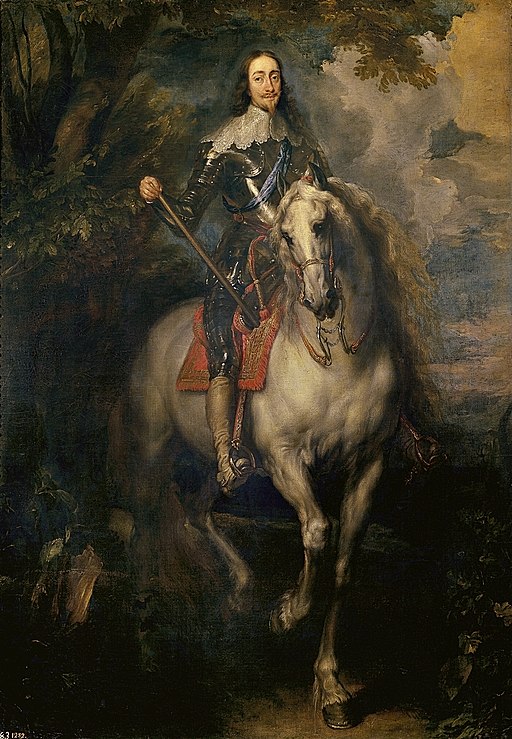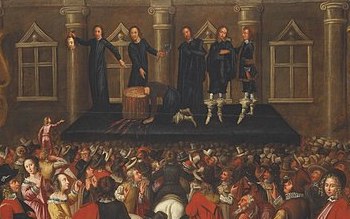On the night of 9th February 1649, King Charles I was buried in St. George’s Chapel, Windsor. He should have been buried in Westminster Abbey but permission was refused by the commission who tried him for treason, so he was laid to rest in St George’s Chapel at Windsor Castle. But what events led to this King’s demise?
Charles I succeeded to the throne in March 1625. Back then the events that were to follow were unimaginable, even to most of the men who signed his eventual death warrant. However, Charles’ unshakeable belief in the Divine Right of Kings soon brought him into conflict with his Parliament.
 The raising of taxes, many of these were old and obscure, and his marriage to the Roman Catholic Henrietta Maria only further increased the hatred and anger that was directed towards him. Ship tax, for example, traditionally paid in times of war for the defence of the coastline was now to be paid all the time. One year later, in 1643, he went further and demanded this same tax from people living inland.
The raising of taxes, many of these were old and obscure, and his marriage to the Roman Catholic Henrietta Maria only further increased the hatred and anger that was directed towards him. Ship tax, for example, traditionally paid in times of war for the defence of the coastline was now to be paid all the time. One year later, in 1643, he went further and demanded this same tax from people living inland.
Coupled with this was his stance on religion. Not only had he married Henrietta Maria, but he was also turning the churches back into “Catholic Shrines” again by elaborately decorating them. He also introduced a new prayer book and to make matters worse, he demanded that this same prayer book be introduced in Scotland. This caused a riot as the Scots were even more anti-Catholic than the English. Charles sent an army north but it was defeated, and he had to pay the Scots off until the matter was decided.
To pay for this army Charles had to recall Parliament in 1640. For 11 years Parliament had not met. A time known as the 11 Years’ Tyranny. Thus, when they met, they were in no mood to give Charles what he wanted, and he tried to dissolve Parliament again after they gave him a list of grievances called the Grand Remonstrance in November 1641.
The following January, Charles burst into the Houses of Commons to arrest the leading five M.P.s, against the rights and freedoms of the Commons. The M.P.s had been tipped off and had fled. The Speaker of the House, William Lenthall, replied to Charles’ demand for information as to their whereabouts by saying, “I have neither eyes to see nor tongue to speak in this place but as this house is pleased to direct me whose servant I am here.”
In June of that year, Parliament passed a new set of demands called the 19 Propositions. This curtailed the power of the King further and would increase the control of Parliament. This divided the Commons but also had the effect of entrenching the views of both sides. Both Parliament and the King began to gather armies and war became inevitable.
On 22nd August 1642, the King raised his standard at Nottingham and the first battle took place at Edgehill, Warwickshire on 23rd October. Parliament’s forces were led by Oliver Cromwell. Cromwell raised, what was called the New Model Army, which was in essence, a professional army, being both organised and trained.
The English Civil War, also known as the Great Rebellion, lasted almost seven years. The King’s army was eventually defeated and following a trial in London King Charles I was found guilty of treason against England by using his power to pursue his personal interest rather than the good of the country. He was sentenced to death.
 On a freezing cold day on 30th January 1649, Charles I was escorted to the Banqueting House in Whitehall, London where a large scaffold had been set up. He wore two shirts so that he wouldn’t shiver from the cold, in case people thought he was trembling in fear. Charles made a short speech, declaring his innocence of the crimes of which parliament had accused him. He then said a short prayer and just after 2 pm, he was dead, executed with one blow.
On a freezing cold day on 30th January 1649, Charles I was escorted to the Banqueting House in Whitehall, London where a large scaffold had been set up. He wore two shirts so that he wouldn’t shiver from the cold, in case people thought he was trembling in fear. Charles made a short speech, declaring his innocence of the crimes of which parliament had accused him. He then said a short prayer and just after 2 pm, he was dead, executed with one blow.
Know an educator who would like this story? Share it with them and connect with us on Facebook, Twitter or Pinterest for more teaching ideas.
Tips for educators:
- Download and print our new 10 facts infographic resource on King Charles I.
- Watch a FREE 60 Second Histories clip about King Charles execution.
- Save time surfing the internet for further resources. Subscribe to 60 Second Histories and get film clips, quizzes and lesson plans to help you teach the English Civil War, as well as many more topics.


